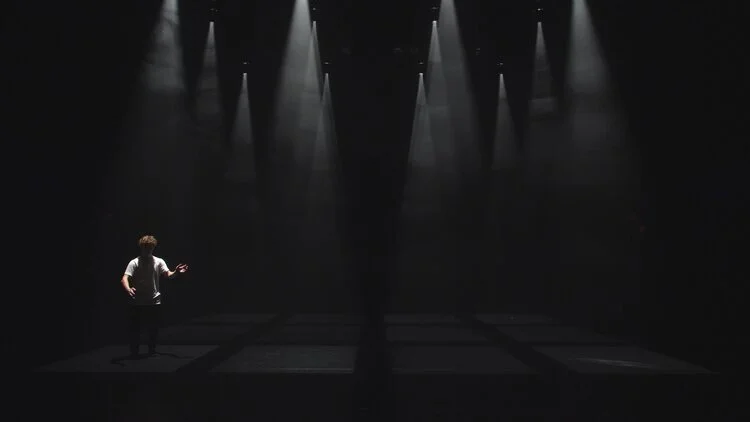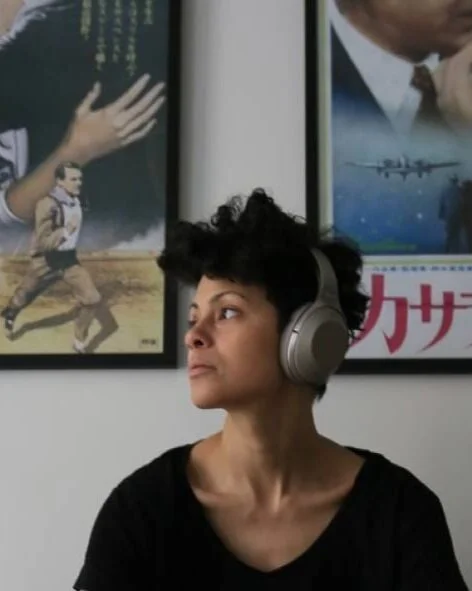End of an era as dance artist Amber Funk Barton prepares for final chapter of the response
The choreographer-performer appears in the fittingly titled How to Say Goodbye before stepping away from company
Isak Enquist in How to Say Goodbye. Photo by Burkeville Productions
Amber Funk Barton. Photo by Chris Barton
The Shadbolt Centre for the Arts streams the response’s How to Say Goodbye/The Final Chapter for free on April 29 at 7 pm
IT’S ALL TOO fitting and bittersweet that the last performance by the response., the indie dance company artist Amber Funk Barton kicked off 13 years ago, should end with a work called How to Say Goodbye/The Final Chapter.
It’s been a long exciting journey for the choreographer and performer who came out of the Goh Ballet and Arts Umbrella training programs two decades ago, into a scene that gave birth to an exciting new generation of Vancouver dance artists. Think Company 605, Radical System Art, and Out Innerspace Dance Theatre/Modus Operandi, all of whose members shared the stage in Barton’s early explosive works like Status Quo and Risk. And so much about her story captures both the DIY potential and challenges for independent artists operating in this city.
“I’m going through a lot of different emotions,” Barton admits to Stir in an interview before the free streamed performance of three solos from the Shadbolt Centre. “I’ve done everything I wanted to do and more in dance. Stepping down, I feel like I experienced all that I wanted and needed to in that formalized structure of a company….There’s so much administration and organization. I have loved every moment, but at a certain point when you’re on your own and don’t have infrastructure or staff, it’s not sustainable.”
Barton, who has a long history of mentoring younger artists, intends to pass the company, under a new name, on to a new emerging dance artist; that announcement will be made after the Shadbolt shows, in which Barton will perform.
The artist says she first got the inkling that it was time to move on after performing her solo VAST in 2019, before the pandemic hit. After years of conjuring ambitious group works, she had rediscovered the draw of the solo form that she had started her career with.
“Solo work feels right to me, and I had to go on a huge journey to realize that was enough for me,” she reflects. “VAST was the catalyst for, ‘Oh, maybe I don’t need a company anymore. Maybe I’m doing this thing I don’t need to do; you’re just buying being on your own. You’re good enough to just be on your own and don’t need these structures.’”
She ended up working on three more solos for How to Say Goodbye—for dancers Isak Enquist, Katie Cassady, and Josh Martin—forced to move to a Zoom creation process when COVID hit.
The title and themes seem incredibly prescient now, but they were inspired by her experience visiting her dying grandfather, who passed away after a long illness in 2020 in Seattle. She remembered being aware of the fact she was saying goodbye—and then, in the studio, started exploring the idea that we can’t control when people come into or leave our lives. The result is an especially haunting trio of solos, which she reworks for this version, How to Say Goodbye: The Final Chapter—stepping in to perform the solo originally created with Martin, whose own Brimming at the VIDF prevented him from taking part this time.
Barton observes that How to Say Goodbye is one of her most mature works. And it has proven eerily prescient, taking on extra resonance now that so many people have had to suffer through absences and loss during the pandemic.
“I’m so proud of this work and that we were able to make something so beautiful out of such an insane time,” she says.
For Barton, COVID brought the need to step away from her company into relief. But she’s still dealing with her own “loss” around the idea of giving up a dream she took on in her 20s. It was a huge undertaking, setting up a nonprofit, a board, and an entire infrastructure that would take her to Vancouver stages and out on tours to spots from Cardiff, Wales to the NW New Works Festival in Seattle. Running the response. was something she assumed she’d do for the rest of her life.
But lately, she’s found other inspiration—through teaching, through choreography for stage shows (King Arthur’s Night, Mortified), and other projects. She doesn’t want to step away from dance entirely, just the demands of running a company.
“I’m dealing with the idea that I failed, even though I know it’s not true,” Barton says candidly. “But that’s important to talk about, because there’s not many times in the community where people do step down and decide to hand over the company to somebody else—to say it’s okay to change and it’s okay not to hang on to your plan from when you were 20.”
And so, while Barton teaches us “how to say goodbye”, she’s also teaching us something else she’s learned over more than a dozen years of running her own company and creating work: as she puts it, “It’s just being able to embrace and accept yourself.”














